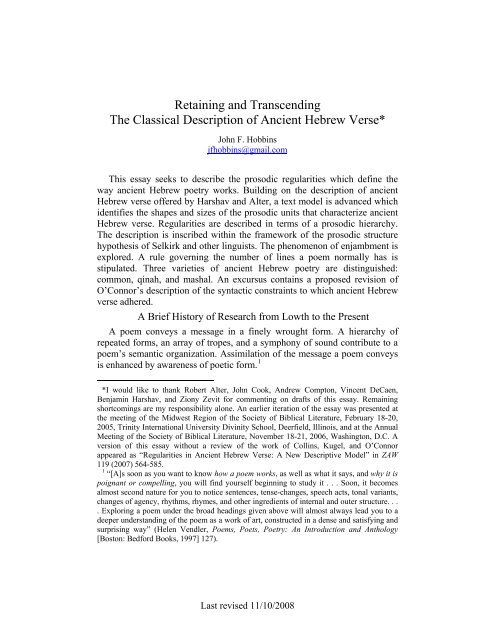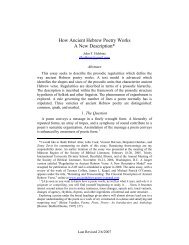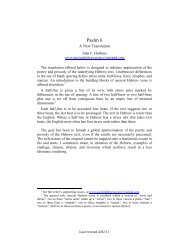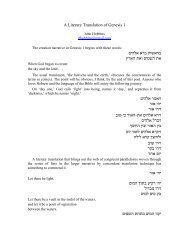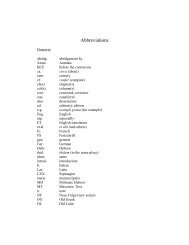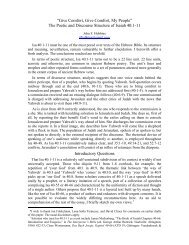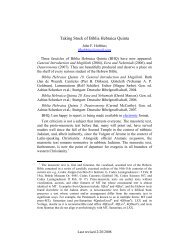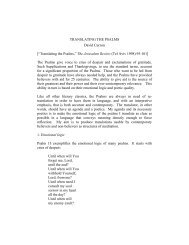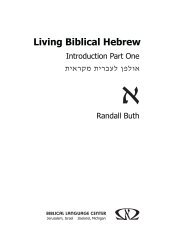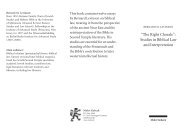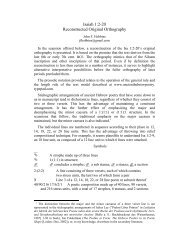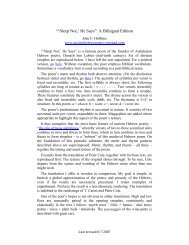Here - Ancient Hebrew Poetry - Typepad
Here - Ancient Hebrew Poetry - Typepad
Here - Ancient Hebrew Poetry - Typepad
- No tags were found...
Create successful ePaper yourself
Turn your PDF publications into a flip-book with our unique Google optimized e-Paper software.
Retaining and TranscendingThe Classical Description of <strong>Ancient</strong> <strong>Hebrew</strong> Verse*John F. Hobbinsjfhobbins@gmail.comThis essay seeks to describe the prosodic regularities which define theway ancient <strong>Hebrew</strong> poetry works. Building on the description of ancient<strong>Hebrew</strong> verse offered by Harshav and Alter, a text model is advanced whichidentifies the shapes and sizes of the prosodic units that characterize ancient<strong>Hebrew</strong> verse. Regularities are described in terms of a prosodic hierarchy.The description is inscribed within the framework of the prosodic structurehypothesis of Selkirk and other linguists. The phenomenon of enjambment isexplored. A rule governing the number of lines a poem normally has isstipulated. Three varieties of ancient <strong>Hebrew</strong> poetry are distinguished:common, qinah, and mashal. An excursus contains a proposed revision ofO’Connor’s description of the syntactic constraints to which ancient <strong>Hebrew</strong>verse adhered.A Brief History of Research from Lowth to the PresentA poem conveys a message in a finely wrought form. A hierarchy ofrepeated forms, an array of tropes, and a symphony of sound contribute to apoem’s semantic organization. Assimilation of the message a poem conveysis enhanced by awareness of poetic form. 1*I would like to thank Robert Alter, John Cook, Andrew Compton, Vincent DeCaen,Benjamin Harshav, and Ziony Zevit for commenting on drafts of this essay. Remainingshortcomings are my responsibility alone. An earlier iteration of the essay was presented atthe meeting of the Midwest Region of the Society of Biblical Literature, February 18-20,2005, Trinity International University Divinity School, Deerfield, Illinois, and at the AnnualMeeting of the Society of Biblical Literature, November 18-21, 2006, Washington, D.C. Aversion of this essay without a review of the work of Collins, Kugel, and O’Connorappeared as “Regularities in <strong>Ancient</strong> <strong>Hebrew</strong> Verse: A New Descriptive Model” in ZAW119 (2007) 564-585.1 “[A]s soon as you want to know how a poem works, as well as what it says, and why it ispoignant or compelling, you will find yourself beginning to study it . . . Soon, it becomesalmost second nature for you to notice sentences, tense-changes, speech acts, tonal variants,changes of agency, rhythms, rhymes, and other ingredients of internal and outer structure. . .. Exploring a poem under the broad headings given above will almost always lead you to adeeper understanding of the poem as a work of art, constructed in a dense and satisfying andsurprising way” (Helen Vendler, Poems, Poets, <strong>Poetry</strong>: An Introduction and Anthology[Boston: Bedford Books, 1997] 127).Last revised 11/10/2008
2That being so, a reader of ancient <strong>Hebrew</strong> poetry will eventually ask:What continuously operating principles of organization define how ancient<strong>Hebrew</strong> poetry works? 2 What formal structures set poetry apart fromnarrative or speech as they otherwise occur in ancient <strong>Hebrew</strong> literature? Arethere rules that govern the formation of a poetic line or composition, rules wedo not fully understand, or have yet to be discovered?Many and various attempts have been made to answer the abovequestions. Robert Lowth paved the way in his lectures on “the sacred poetryof the <strong>Hebrew</strong>s,” 3 and in a translation of Isaiah and commentary thereto. 4 He2 “[A]s soon as we perceive that a verbal sequence has a sustained rhythm, that it isformally structured according to a continuously operating principle of organization [myitalics], we know that we are in the presence of poetry and we respond to it accordingly”(Barbara Herrnstein Smith, Poetic Closure: A Study of How Poems End [Chicago:University of Chicago Press, 1968], 23; quoted in Robert Alter, The Art of Biblical <strong>Poetry</strong>[New York: Basic Books, 1985] 6).3 Robert Lowth, De sacra poesi Hebraeorum: praelectiones academicae Oxonii habitae,subjicitur metricae Harianae brevis confutatio et oratio Crewiana (Oxford: Clarendon,1753). Johann David Michaelis reprinted the lectures shortly thereafter with annotations: Desacra poesi Hebraeorum . . . notas et epimetra adjecit Ioannes David Michaelis (Göttingen:Pockwiz u. Barmeier, 1758-61). Lowth commends the annotations in the lectures’ secondedition (Oxford: Clarendon, 1763) and had them printed at Oxford: Johannis DavidisMichaelis . . . in Roberti Lowth praelectiones de sacra poesi Hebraeorum notae et epimetra:ex Goettingensi editione praelectionum (Oxford: Clarendon, 1763). The definitive edition ofthe lectures is the third (Oxford: Clarendon, 1775; repr. with introd. by David Reibel; RobertLowth [1710-1787]: The Major Works; London: Routledge / Thoemmes Press, 1995).Lowth’s work and a portion of the notes by Michaelis (but not, for example, his excursus onparallelism, an addendum to Lecture XIX on Prophetic <strong>Poetry</strong>) later appeared in English:Lectures on the Sacred <strong>Poetry</strong> of the <strong>Hebrew</strong>s: From the Latin of the late Robert Lowth, byG. Gregory; to which are Added the Principal Notes of Professor Michaelis and Notes bythe Translator and Others (London: J. Johnson, 1787; repr. with introd. by VincentFreimarck; bibliogr. note by Bernhard Fabian; 2 vols.; Anglista and Americana 43;Hildesheim: Georg Olms, 1969; repr. with introd. by David Reibel; Robert Lowth [1710-1787]: The Major Works; London: Routledge / Thoemmes Press, 1995; repr. of the 4th ed.[London: T. Tegg, 1839]; Whitefish: Kessinger, 2004). The hallmark of <strong>Hebrew</strong> poetryLowth identified, varieties of parallelism across the members of a verse, had, unbeknownstto him, been noted by Finnish scholars before him, aided by the fact that Finnish folk poetryis replete with analogous phenomena: Ericus Cajanus, Linguarum Ebraeae et Finnicaeconvenientia (diss., Turku [Åbo]: Johan Wall, 1697) 12f.; Daniel Juslenius, Oratio deconvenientia linguae Fennicae cum Hebraea et Graeca (Turku [Åbo], 1712; repr. inSchwedische Bibliothec, in welcher verschiedene . . . Schrifften . . . als auch alle Disciplinenund Facultäten betreffende alte und neue Erfindungen . . . gesammlet . . .werden [ed.Christian von Nettelbladt; 5 vols.; Stockholm / Rostock / Leipzig: Rußworm, 1728-1736]1:157-68; 163; citations of both in Wolfgang Steinitz, Der Parallelismus in der finnischkarelischenVolksdichtung (Folklore Fellows Communications 115; Helsinki: Suomalainen
3noted that poetic texts in the <strong>Hebrew</strong> Bible consist of verses formed of two -or more rarely three - stichoi or “members.” He described parallelism acrossthe members of a verse as the chief hallmark of ancient <strong>Hebrew</strong> poetry.Tiedeakatemia, 1934) 14-15. Before Lowth, Christian Schoettgen described <strong>Hebrew</strong> poetryin similar and sometimes more penetrating terms (“De exergasia sacra” in ChristianiSchoettgenii Horae Hebraicae et Talmudicae in universum novum testamentum . . .Accedunt dissertationes quaedam philologico-sacrae I [Dresden / Leipzig: Christoph.Heckel, 1733] 1249-63; ET with introd. Jack R. Lundbom, Jeremiah: A Study in <strong>Ancient</strong><strong>Hebrew</strong> Rhetoric [SBLDS 18, Missoula: Scholars Press, 1975] 121-127; [2d ed.; WinonaLake: Eisenbrauns, 1997] 155-163). Alessio Simmaco Mazzocchi also anticipated Lowth’sfindings, as shown by Ugo Bonamartini (“L’epesegesi della S. Scrittura,” Bibl 6 [1925] 424-44). Following Lowth, Johann Gottfried Herder described <strong>Hebrew</strong> poetry with unalloyedenthusiasm in Vom Geist der ebräischen Poesie: Eine Anleitung Liebhaber derselben, undder ältesten Geschichte menschlichen Geistes (2 vols.; Dessau: auf Kosten der Verlags-Kasse, und zu finden in der Buchhandlung der Gelehrten, 1782-1783); ET The Spirit of<strong>Hebrew</strong> <strong>Poetry</strong> (2 vols.; tr. James Marsh; Burlington: E. Smith, 1833); for key quotes, seePatrick D. Miller, Jr., “Meter, Parallelism, and Tropes: The Search for Poetic Style,” JSOT28 (1984) 99-106; 101, 102-103 (repr. in idem, Israelite Religion and Biblical Theology:Collected Essays [JSOTSup 267; Sheffield: Sheffield Academic Press, 2000] 250-258). Forthe history of reception of De sacra poesi Hebraeorum and Isaiah (see next note), see theintroductions in the reprint eds.; Aelred Baker, “Parallelism: England’s Contribution toBiblical Studies,” CBQ 35 (1973) 429-40; Christoph Bultmann, Die biblische Urgeschichtein der Aufklärung: Johann Gottfried Herders Interpretation der Genesis als Antwort auf dieReligionskritik David Humes (BHT 110; Tübingen: Mohr Siebeck, 1999) 75-85; GaryStansell, “Lowth’s Isaiah Commentary and Romanticism,” in Society of Biblical Literature2000 Seminar Papers (SBLSP Series 39; Atlanta: Society of Biblical Literature, 2000) 148-82; Patricia K. Tull, “What’s New in Lowth? Synchronic Reading in the Eighteenth andTwenty-First Centuries,” in SBL 2000 Seminar Papers, 183-217; Robert P. Gordon, “TheLegacy of Lowth: Robert Lowth and the Book of Isaiah in Particular,” in Biblical <strong>Hebrew</strong>s,Biblical Texts: Essays in Memory of Michael P. Weitzman (ed. Ada Rapoport-Albert andGillian Greenberg, JSOTSup 333; The <strong>Hebrew</strong> Bible and its Versions 2; Sheffield: SheffieldAcademic Press, 2001) 57-76; Rudolf Smend, “Der Entdecker des Parallelismus: RobertLowth (1710-1787).” in Prophetie und Psalmen: Festschrift für Klaus Seybold zum 65.Geburtstag (ed. Beat Huwyler, Hans-Peter Mathys, and Beat Weber; AOAT 280; Münster:Ugarit-Verlag, 2001) 185-99; Gary Stansell, “The Poet’s Prophet: Bishop Robert Lowth’sEighteenth-Century Commentary on Isaiah,” in “As Those Who Are Taught”: TheInterpretation of Isaiah from the LXX to the SBL (ed. Claire Mathews McGinnis and PatriciaK. Tull; SBL Symposium Series 27; Atlanta: SBL, 2006) 223-242.4 Isaiah: A New Translation with a Preliminary Dissertation and Notes (London: J.Dodsley for J. Nichols, 1778; repr. with introd. by David Reibel; Robert Lowth [1710-1787]: The Major Works; London: Routledge / Thoemmes Press, 1995; 10th ed.; London: T.Tegg, 1833; Ger. tr. Johann Benjamin Koppe, D. Robert Lowth's . . . Jesaias, neu übers.nebst einer Einleitung und . . . Anmerkungen. Aus dem Engl., mit Zusätzen undAnmerkungen von J.B. Koppe (4 vols.; Leipzig: Weidmann, 1779-81).
4Lowth believed that ancient <strong>Hebrew</strong> verse instantiated metrical structures,but he deemed them irrecoverable given our ignorance of the pronunciationand stress rules of pre-Masoretic <strong>Hebrew</strong>. On the other hand, he favorablyreviewed the metrical theory of Azariah de’ Rossi. De’ Rossi noted theproportions of 2:2 and 3:3 that recur in biblical poetry. He counted neithersyllables nor words, but “thought” units that might consist of one, two, orsometimes three words. In his study of Isaiah, Lowth noted imperfections inthe approach and its application by de’ Rossi, but endorsed the finding ofrecurring proportions, and gave examples of his own. 5Since Lowth, most have concurred that parallelism is the chief hallmarkof ancient <strong>Hebrew</strong> poetry and not a few have tried to improve upon Lowth’sclassification of its types. Many have sought to recover a metercorresponding to a perception of recurring proportions across the parts thatmake up a poetic line. But others have found the concept of parallelism, or ofa bi- and sometimes tripartite line, or of meter, or of poetry, to be unhelpfulin describing texts generally thought to be examples of ancient <strong>Hebrew</strong>verse. 6Disagreement has been sharp and shows no signs of abating. It mightseem hard to identify even a minimal description of ancient <strong>Hebrew</strong> verseable to claim the assent of a majority of its students.But perhaps we know more than we imagine about ancient <strong>Hebrew</strong> verse.In order to test the possibility that the classical description remains a validpoint of departure for ongoing research, it will be helpful to examine andcritique recent reformulations of it.5 Lowth argues that <strong>Hebrew</strong> poetry is metrical in Lecture III (Lectures [2004] 28-36). Hetouches upon de’ Rossi’s proposals in Lecture XIX (200-215; 214-15). In his “PreliminaryDissertation,” he discusses them at length (Isaiah [4th ed.] 5-45; 37-45). For the theory inquestion, see Azariah (Bonaiuto) ben Moshe de’ Rossi, מְ אוֹר עֵ ינַ יִם (Mantua, 1573; republ. asrepr. [3 vols.; Vilna: S. I. Fin & A. G. Rozenkrants, 1863-65] 623-26; ספר מאור עיניםJerusalem: Makor, 1969 or 1970]); Lat. tr. Johannes Buxtorf, Jr., Liber Cosri [Kuzari](Basel: Georg Decker, 1660) 415-24; ET with introd. Adele Berlin, Reading Biblical <strong>Poetry</strong>through Medieval Jewish Eyes (IndStBibLit; Bloomington: Indiana University Press, 1991)141-53; ET with introd. Joanna Weinberg, The Light of the Eyes / Azariah de’ Rossi:Translated from the <strong>Hebrew</strong> with an Introduction and Annotations (YJS 31; New Haven:Yale University Press, 2001) 710-21.6 Challenges to the classical description include those mounted by Collins, Kugel, andO’Connor. See the next section. For a concise survey of other approaches and abibliography, see the present writer’s “Meter in <strong>Ancient</strong> <strong>Hebrew</strong> <strong>Poetry</strong>: A History ofModern Research” at www.ancienthebrewpoetry.typepad.com.
5Restatements of the Classical DescriptionThe most trenchant restatement of the classical description known to thepresent writer is that of Benjamin Harshav [Hrushovski] as summarized byRobert Alter:Hrushovski proposes a “semantic-syntactic-accentual rhythm” as the basis ofbiblical verse. “In most cases,” he observes, “there is an overlapping of severalsuch heterogeneous parallelisms with a mutual reinforcement so that no singleelement - meaning, syntax, or stress - may be considered as purely dominant oras purely concomitant.” The result is what Hrushovski defines as a “freerhythm” . . . [nevertheless,] the freedom of the rhythm “is clearly confinedwithin the limits of its poetics.” These limits are in part numerically demarcated,as Hrushovski [notes]: “[Since] by rule no two stresses are permitted to followeach other . . . each stress dominates a group of two, three, or four syllables;there are two, three, or four such groups in a verset; and two, three, or fourparallel versets in a sentence.” 7Mutually reinforcing parallelisms of meaning, syntax, and stress, asHarshav sees it, are the hallmark of ancient <strong>Hebrew</strong> poetry. These occurwithin a system of “twos, threes, and fours”: “stress-units” made up of two,three, or four syllables, “versets” made up of two, three, or four stress units,and “sentences” made up of two, three, or four versets. The rhythm ofstresses is so strong, Harshav notes, that it sometimes serves as the solesupport of parallelism across contiguous versets. A verset of two to fourstress units is unfailingly followed by another verset of two to four stressunits. Within and across the prosodic frames demarcated by stressparallelisms, a gamut of freely distributed sonic parallelisms also findsexpression. As Harshav remarks elsewhere, the process of interaction ofsounds and meanings encourages a selection and reemphasis of elementsfrom both sides. 87 Alter, Art of Biblical <strong>Poetry</strong>, 8, quoting from B. Hrushovski, “Prosody, <strong>Hebrew</strong>,” EncJud13 (1971) cols. 1195-1240; 1200-1202. Harshav’s analysis benefits from his grasp of theentire history of <strong>Hebrew</strong> prosody. Not to be overlooked is his brief synopsis entitled, “Noteon the Systems of <strong>Hebrew</strong> Versification,” in The Penguin Book of <strong>Hebrew</strong> Verse (ed. T.Carmi; Harmondsworth: Penguin, 1981), 57-72; the “Preface,” “Introduction,” “Note onMedieval <strong>Hebrew</strong> Genres,” and “Table of Poems” by T. Carmi in the same volume, and thepoems themselves; at least those in “Part One: To the Tenth Century,” deserve a widereading among biblical scholars (7-12; 13-50; 51-55; 77-143; 147-274).8 Hrushovski, “Prosody,” 1202; idem, “The Meaning of Sound Patterns in <strong>Poetry</strong>: AnInteraction Theory,” Poetics Today 2/1 (1980) 39-56; 43.
7in relation to the number of the sons of Israel;9 for Yahweh’s portion is his people,Jacob his allotted parcel.10 He found him in the desert land,in the emptiness of howling Jeshimon;he encircled him, gave thought to him,watched him like the apple of his eye.11 Like an eagle he would rouse his nest,over his fledglings he would hover,he spread his wings, he took him,he bore him on his plumage.It is not difficult to see that 32:7 and 11, like 8 and 10, are best parsed aspairs of bipartite lines. 12 A pair of poetic lines constitutes a largersubdivision of the text, which we shall call, in agreement with JanFokkelman, a “strophe.” 13 The situation seems to be the following: when twoor three versets form a pasuq in the transmitted textual division, a poetic line,at least on the face of it, is delimited; when four or more versets form abiblical verse, a hierarchically superior subdivision of the text is delimited. 14The formatting of poetry in BHS and the JPS <strong>Hebrew</strong>-English Tanakh isconsistent with Alter’s refinement of Harshav’s description in most12 In Codex Aleppo’s layout, vv. 7 and 11 frame the core of a unit whose heart of hearts isv. 9, the one pasuq in the context to consist of a single bipartite poetic line. MT Deut 32:8-9,it should be pointed out, preserves a revision, albeit ancient, of an earlier text reflected inother witnesses. It seems likely that Deut 32:8 originally concluded with בני אל (4QDt j ) and32:9 originally began with ויהי (reflected in G καί ε̉γενήθη). For a discussion, see Jeffrey H.Tigay, Deuteronomy: The Traditional <strong>Hebrew</strong> Text with the New JPS Translation [and]Commentary (JPSTC; Philadelphia: Jewish Publication Society, 1996) 302-303, 402-403,513-18, 546-47. The revision preserved in MT stays within the bounds of the constraintsancient <strong>Hebrew</strong> poetry worked within. A historical setting for a series of ancientemendations at Gen 46:27; Exod 1:5; and Deut 32:8, 43 is hypothesized by Arie van derKooij, “<strong>Ancient</strong> Emendations in MT,” in L’Ecrit et l’Esprit: Études d’histoire du text et dethéologique biblique en hommage à Adrian Schenker (ed. Dieter Böhler, Innocent Himbaza,and Philippe Hugo; OBO 214; Fribourg/Göttingen: Academic Press / Vandenhoeck &Ruprecht, 2005) 152-159; 155-59.13 Jan P. Fokkelman, Reading Biblical <strong>Poetry</strong>: An Introductory Guide (tr. Ineke Smit;Louisville: Westminster John Knox Press, 2001) 37.14 Examples of 4 or more versets to a verse, see Num 24:9; Deut 32:36; 33:9, 21; 2 Sam1:23, 26; Isa 1:3, 4, 6, 17; Obad 5; and Ps 27:1.
8instances. 15 Similar analyses underlie the formatting of <strong>Hebrew</strong> poetry ofmost modern translations of the Bible – for example, the NRSV, theTraduction Œcuménique de la Bible, La Biblia del Peregrino, La SacraBibbia della Conferenza Episcopale Italiana, and the Einheitsübersetzungder Heiligen Schrift. 16 There seems to be more agreement about basic formalaspects of ancient <strong>Hebrew</strong> poetry than we sometimes realize.Adele Berlin’s recent overview in the Jewish Study Bible emphasizesprecisely those formal aspects of ancient <strong>Hebrew</strong> poetry about which thereshould be general agreement. Again we hear that parallelisms are the chiefhallmark of ancient <strong>Hebrew</strong> poetry, with pride of place given to syntacticand semantic parallelisms. Again we are told that the basic structural unit ofa poem is not a single “line” – what Harshav and Alter refer to as a “verset”– but a set of parallel “lines” two or three in number. Again we have arecognition of “balance” between parallel “lines,” though Berlin notes thatno system of numerical demarcation – be it counting of syllables, stresses,syntactic units, or “thoughts” – has met with anything like generalacceptance. 17In an overview of his own, Alter reiterates the importance of parallelismsof meaning, syntax, and rhythmic stresses in biblical verse, by no meansalways in coordination with each other. He emphasizes that the parallelismbetween contiguous versets of a poetic line is sometimes limited to one ofstresses. 18 Innumerable scholars have emphasized the importance of stressparallelism. Harshav references Joachim Begrich, whose review of researchin his day is still helpful and whose study of syntactic frames in the context15 Biblia Hebraica Stuttgartensia (ed. Karl Elliger and Wilhelm Rudolph; 5th ed.;Stuttgart: Deutsche Bibelgesellschaft, 1997 [originally 1967-77]); JPS <strong>Hebrew</strong>-EnglishTanakh: The Traditional <strong>Hebrew</strong> Text and the New JPS Translation (2d ed.; Philadelphia:Jewish Publication Society, 1999).16 The HarperCollins Study Bible: New Revised Standard Version (gen. ed. Wayne A.Meeks; New York: HarperCollins, 1993); Traduction Œcuménique de la Bible. EditionIntegrale. Ancien Testament (Paris: Cerf, 1980); Biblia del Peregrino. Edición de Estudio 1-3: Antiguo Testamento, prosa; Antiguo Testamento, poesía; Nuevo Testamento (3d ed.; ed.Luis Alonso Schökel; Bilbao: Mensajero, 2005 [1997]; Port. trans. Biblia do peregino (SãoPaulo: Paulus, 2002); La Bibbia di Gerusalemme: Testo biblico di La Sacra Bibbia dellaCEI (“editio princeps” 1971; Bologna: Edizioni Dehoniane, 1986); Einheitsübersetzung derHeiligen Schrift (Stuttgart: Katholische Bibelanstalt, 1980).17 Adele Berlin, “Reading Biblical <strong>Poetry</strong>,” in The Jewish Study Bible (ed. Adele Berlinand Mark Zvi Brettler; Oxford: Oxford University Press, 2004) 2097-2104; 2098-99.18 Robert Alter, “The Characteristics of <strong>Ancient</strong> <strong>Hebrew</strong> <strong>Poetry</strong>,” in The Literary Guide tothe Bible (ed. Robert Alter and Frank Kermode; Cambridge: Harvard University Press,1987) 611-24; 612-15.
9of a theory of stress parallelisms anticipates the interest in syntax thatcharacterizes the more recent work of Collins and O’Connor. Alterreferences John Bright, whose exposition of the Ley-Sievers system asemployed in his generation remains the most lucid available in the Englishlanguage. The work of George Buchanan Gray, Hans Wildberger, LuisAlonso Schökel, and Leslie Allen might also be singled out. All applied thestress-counting method to a large corpus of texts in a consistent manner. 19Harshav, Alter, and Berlin refine and rework the classical descriptiongoing back to Lowth. Harshav and Alter reclaim the method of primarystress analysis associated with the names of Julius Ley and Eduard Sievers. 20If they are right to do so, we may still pose the question: What about thework of those who reject the description of parallelism as the hallmark ofancient <strong>Hebrew</strong> poetry and forgo the search for prosodic regularities therein?Is the work of those who set the classical description aside nonethelesscompatible with it?Collins, Kugel, and O’ConnorTerence Collins’ description of line-forms in <strong>Hebrew</strong> poetry, as heremarks, “can be looked on as a system of measurement, determining what isa well formed verse-line and thus performing the same function as the more19 Joachim Begrich, “Zur hebräische Metrik,” TRu NF 4 (1932) 67-89; “Der Satzstil imFünfer,” ZS 9 (1933-34) 169-209; repr. idem, Gesammelte Studien zum Alten Testament (ed.Walther Zimmerli; TB 21; Munich: Chr. Kaiser, 1964) 132-67; John Bright, Jeremiah (AB21; New York: Doubleday, 1965) cxxvi-cxxxviii; George Buchanan Gray (The Forms of<strong>Hebrew</strong> <strong>Poetry</strong> [London: Hodder & Stoughton, 1915; repr. Eugene: Wipf & Stock, 2002)];idem, Isaiah I-XXXIX [chs. 1-27 alone are covered] [ICC; Edinburgh: T & T Clark, 1912];Samuel R. Driver and George B. Gray, Job [Gray is responsible for the discussion ofrhythms in the introduction and notes] [ICC; Edinburgh: T & T Clark, 1912]); Luis AlonsoSchökel, Estudios de poética hebrea (Barcelona: Juan Flors, 1963) 165-88 [Isa 1-21]; 188-89 [Isa 43-44]; 451-87 [Isa 24-27]; 489-523 [Isa 28-30]; Hans Wildberger, Jesaja: 1.Teilband: Jesaja 1-12 (2d ed., BKAT 10/1; Neukirchen-Vluyn: Neukirchener Verlag, 1980[ET Isaiah 1-12 (CC; Minneapolis: Fortress, 1990)]; idem, Jesaja: 2. Teilband: Jesaja 13-27(BKAT 10/2, Neukirchen-Vluyn: Neukirchener Verlag, 1978 [ET Isaiah 13-27 (CC;Minneapolis: Fortress, 1997)]; idem, Jesaja: 3. Teilband: Jesaja 28-39 (BKAT 10/3;Neukirchen-Vluyn: Neukirchener Verlag, 1982 [ET Isaiah 28-39 (CC; Minneapolis:Fortress, 2002)]; Leslie C. Allen, Psalms 101-150 (2d ed.; WBC 21; Nashville: ThomasNelson, 2002).20 Where Ley and Sievers differ, Ley’s approach seems of more enduring value. See thewriter’s “Meter in <strong>Ancient</strong> <strong>Hebrew</strong> <strong>Poetry</strong>: A History of Modern Research,”ancienthebrewpoetry.typepad.com.
10familiar systems of meter.” 21 But Collins did not complete the task ofcompiling a taxonomy of line-forms. The phrase-structure rules andtransformation rules he formulates generate less than half of the lines in hiscorpus. Incomplete as Collins’ analysis is, it describes with a degree ofprecision a set of line-types that occur in very different proportions withinone poem as opposed to another. The divergent proportions and anyimplications there from in terms of genre or style or history of prosodydeserve further study.A simple fact is worth noting: Collins’ analysis does not contradict theclassical description. After all, there are multiple ways of determining what awell-formed line is. A taxonomy based on grammatical structures is oneway. A system of measurement based on stress parallelisms might beanother. Collins makes the same point:[T]he <strong>Hebrew</strong> verse-line is far too complex and delicate a thing to respond toany one-track investigation. The line is made up different layers – grammaticalstructure, semantic structure, stress patterns, syllable counts, alliteration – and afull stylistic analysis can only be achieved when we have observed thefunctioning of each layer individually and then studied how collectively theyinteract and contribute in different ways to the overall effect of the line. 22James Kugel’s Idea of Biblical <strong>Poetry</strong> stands, on the theoretical plane,over against the classical description. 23 His polemics are not without salutarycomponents. Nevertheless, Alter’s critique of Kugel’s rejection of importantfeatures of the classical description, which I will not summarize here, is spoton. 24 The value of Kugel’s work lies in the attention to detail in his exegesis.Kugel’s insights into the phenomenon of semantic parallelism, worked outindependently and more systematically by Alter, represent a refinement ofthe classical description, not a challenge to it.There is more agreement between Kugel’s idea of biblical poetry and theclassical description than meets the eye. As Kugel states in Great Poems ofthe Bible:21 Terence Collins, Line-forms in <strong>Hebrew</strong> <strong>Poetry</strong>: A Grammatical Approach to the StylisticStudy of the <strong>Hebrew</strong> Prophets (Studia Pohl, Series Maior 7; Rome: Biblical Institute Press,1978) 16.22 Line-forms, 227, quoted in Donn W. Leatherman (An Analysis of Four Current Theoriesof <strong>Hebrew</strong> Verse Structure [Ph.D. diss., McGill University, Montreal, 1998] 54-55), athttp://www.collectionscanada.ca/obj/s4/f2/dsk1/tape10/PQDD_0028/NQ50205.pdf.23 James L. Kugel, The Idea of Biblical <strong>Poetry</strong>: Parallelism and Its History (New Haven:Yale University Press, 1981; repr. Baltimore: Johns Hopkins University Press, 1998).24 Art of Biblical <strong>Poetry</strong>, xi, 4, 6, 8, 10, 18-19.
11[T]he poetry of the Bible . . . is characterized by an ideal sentence form that isrepeated line after line. . . . the sentence form consists of two parts, A and B. .. . The parts are separated by a brief pause . . . and end in a full stop. . . . B25is always a continuation of A.Strange to say, Kugel’s method of formatting a poem does nothing tohighlight his analysis. <strong>Here</strong> is how he formats his translation of the openinglines of Psalm 104:Bless the LORD, O my soul -- O Lord my God,You are very great.Clothed in glory and honor, You wrapped Yourself in light.Then You put up the sky like a tent and covered it over with water.The clouds You took as Your chariot and rode off on the wings of the wind.The winds themselves You made messengers, and flames of fire Yourservants. 26Formatting that reveals the “A continued by B” scheme might look like this:Bless the LORD, O my soul --O Lord my God,You are very great.Clothed in glory and honor,You wrapped Yourself in light.Then You put up the sky like a tentand covered it over with water.The clouds You took as Your chariotand rode off on the wings of the wind.The winds themselves You made messengers,and flames of fire Your servants.M. O’Connor’s <strong>Hebrew</strong> Verse Structure is a monumental study. 27Frustrated by the antiquated and fuzzy categories of the classical description,25 James L. Kugel, The Great Poems of the Bible: A Reader’s Companion with NewTranslations (New York: Free Press, 1999) 19. Kugel remarks that verb ellipsis is “just asimportant as parallelism” as a means for creating a feeling of connectedness between the Aand B segments of a poetic line (21). The phenomena of ellipsis, enjambment, and chiasmusare part of the glue that holds a text together, but occur far less often than parallelisms occur.On the subject of ellipsis, see Cynthia L. Miller, “A Linguistic Approach to Ellipsis inBiblical <strong>Poetry</strong>: (Or, What to Do When Exegesis of What is There Depends on What Isn’t),”BBR 13 (2003) 251-70.26 Great Poems, 26.27 Michael Patrick O’Connor, <strong>Hebrew</strong> Verse Structure (Winona Lake: Eisenbrauns, 1980;reissued 1997 with “The Contours of Biblical <strong>Hebrew</strong> Verse, An Afterword to <strong>Hebrew</strong>Verse Structure” [pp. 631-61]).
12he chucks the description overboard and thus lightens his load as he sets sailfor more hospitable seas. At what he calls the line level, he develops analternative to more familiar systems of meter in the form of a system ofsyntactic constraints. In addition, he develops an alternative to traditionalanalyses of repetition, parallelism, ellipsis, and other phenomena in the formof a classification using new terminology. O’Connor’s “line” corresponds towhat others call a “half-line,” “colon,” or “hemistich,” and what I call a“verset.”O’Connor’s search for principles of organization in the realm of syntax issuccessful where Collins is not in describing parameters that definewellformedness at one level of the textual hierarchy. It is nonethelessprobable that constraints at more than one level determine the way ancient<strong>Hebrew</strong> verse is constructed. This follows from the fact that language ingeneral and poetry in particular instantiate redundant structures on multiplelevels simultaneously. These structures have metrical properties and conformto a system of ranked constraints and preferences. To say so is merely torepeat a widely held axiom of modern linguistics, one manifestation of whichis Optimality Theory. 28 Language in general and poetry in particular displayiterative, constraint-governed patterns at the levels of phonology, prosodichierarchy, stress alignment, lexical, grammatical, and rhetorical stress,morphology, syntax, sentence intonation, discourse grammar, and groupingand closure preferences. At all these levels, it is our task to isolate patternspeculiar to poetry in the context of those that occur in language moregenerally.The real question is to what degree a particular analysis of stressparallelisms, or of syntax at the verset or line level, state matters as they are.That one level of analysis does not rule out another should be obvious. Itfollows that there is no a priori reason for thinking that O’Connor’s systemof syntactic constraints is incompatible with the analysis of semantic andprosodic equivalences implied by the classical description.O’Connor’s description of what he calls the tropes of repetition,coloration, matching, and gapping clarifies and obscures at the same time. Atthe most abstract level, his system, by no longer singling out parallelism as28Alan Prince and Paul Smolensky, Optimality Theory: Constraint Interaction inGenerative Grammar (Report no. RuCCS-TR-2; New Brunswick: Rutgers UniversityCenter for Cognitive Science, 1993). An archive of Optimality studies is available at:http://roa.rutgers.edu. Introductions: René Kager, Optimality Theory (Cambridge Textbooksin Linguistics; Cambridge: Cambridge University Press, 1999); John J. McCarthy, AThematic Guide to Optimality Theory (Cambridge: Cambridge University Press, 2002).
13the chief hallmark of <strong>Hebrew</strong> verse, regresses vis-à-vis the classicaldescription. Recent attention to a range of semantic, syntactic,morphological, and sonic parallelisms confirms that parallelism deservespride of place in a description of ancient <strong>Hebrew</strong> poetry. Apposition,syndetic coordination, and hypotaxis sequences, not considered by O’Connorabove his line level, also form series in parallelism, and reinforce other formsof parallelism. A more frequent use of apposition and a more sparing use ofsyndetic coordination and hypotaxis vis-à-vis prose is typical of ancient<strong>Hebrew</strong> verse. 29O’Connor’s downgrading of the bicolon and tricolon to a “secondary”reality is also questionable. 30 If one is searching for a continuously operatingprinciple of organization of ancient <strong>Hebrew</strong> verse, a line of two or threeversets fits the definition extremely well.On the other hand, O’Connor pays attention to rarely noticed featuresbeyond parallelism that characterize ancient <strong>Hebrew</strong> verse. Examplesinclude patterns of syntactic dependency (enjambment), patterns of constructand adjectival combinations, and the out workings of Panini’s law. 31I have argued that the classical description of ancient <strong>Hebrew</strong> poetryremains a valid point of departure for ongoing research in the field. Asrevised by Harshav and Alter, it deserves to be retained, not set aside. Theway is now clear for a fresh attempt at retaining and transcending thedescription of ancient <strong>Hebrew</strong> poetry that goes back to Lowth, a task towhich I now turn.29 On parallelism, see Adele Berlin, The Dynamics of Biblical Parallelism (Bloomington:Indiana University Press, 1985); Stephen A. Geller, Parallelism in Early Biblical <strong>Poetry</strong>(HSM 20; Missoula: Scholars Press, 1979); Wilfred G. E. Watson, Classical <strong>Hebrew</strong><strong>Poetry</strong>: A Guide to its Techniques (2d ed.; JSOTSup 26; Sheffield: Sheffield AcademicPress, [1984] 1995; London: T. & T. Clark, 2005) 114-159; Traditional Techniques inClassical <strong>Hebrew</strong> Verse (JSOTSup 170; Sheffield: Sheffield Academic Press, 1994) 104-261; and the present writer’s “Parallelisms in <strong>Ancient</strong> <strong>Hebrew</strong> Verse,” at www.ancienthebrewpoetry.typepad.com. For apposition, syndetic coordination, and hypotaxissequences, see the writer’s “Isaiah 1:2-20,” at ancienthebrewpoetry.typepad.com. O’Connorexplicitly leaves an analysis of hypotaxis to one side (<strong>Hebrew</strong> Verse Structure, 305).30 <strong>Hebrew</strong> Verse Structure, 132-35.31129-32, 409-20 (syntactic dependencies); 379-85 (construct and adjectivalcombinations); 98, 100-101 (Panini’s Law).
14A New DescriptionIf there is a part of the description of ancient <strong>Hebrew</strong> verse as set forth byHarshav and Alter that requires qualification, it is that which deals withpatterns of stress parallelism. Alter’s overview makes an excellent startingpoint:The rule is that there are never less than two stresses in a verset and nevermore than four and that no two stresses follow each other without an interveningunstressed syllable; and there are often asymmetrical combinations of 4+3 or323+2.Alter is here restating a rule deemed well-established in the eyes of thosetrained in the system of Ley and Sievers, and applied, for example, to thepoetry contained in Job by Gray, to that contained in Isa 1-39 by Wildberger,and to Pss 101-150 by Allen. 33The rule works remarkably well. That doesn’t mean it is beyondimprovement. The assumption that no two stresses follow each other withoutat least one intervening syllable deserves re-examination. The rule abandonsthe patterns of stress retention reflected in MT insofar as it reduces twostresses to one where two stressed syllables in MT do follow each otherwithout an intervening syllable. Added maqqephim signal stress deletion:הוֹי גּוֹי חֹטֵ אעַ ם כֶּ בֶ ד עָ ו ֹןעַ ל מֶ ה תֻ כּוּ עוֹדעָ רֵ יכֶ ם שְׂ רֻ פוֹת אֵ שצֶ דֶ ק יָלִ ין בָּ הּהוֹי-גּוֹי חֹטֵ אעַ ם-כֶּ בֶ ד עָ ו ֹןעַ ל-מֶ ה תֻ כּוּ-עוֹדעָ רֵ יכֶ ם שְׂ רֻ פוֹת-אֵ שׁצֶ דֶ ק יָלִ ין-בָּ הּMT Isa 1:4MT Isa 1:4MT Isa 1:5MT Isa 1:7MT Isa 1:21Isa 1:4 Oh sinner nation! Oh-nation sinful!Isa 1:4 Iniquity laden people People-laden with-iniquityIsa 1:5 Why shall-you-be-hit again? Why shall-you-be-hit-again?Isa 1:7 Your-cities consumed with-fire Your-cities consumed-with-fireIsa 1:21 Justice dwells in-her Justice dwells-in-herThe “no two stresses in a row” rule looks like an overgeneralization. Thereceived tradition’s frequent non-avoidance of two stresses in a row is32 Alter, “Characteristics of <strong>Ancient</strong> <strong>Hebrew</strong> <strong>Poetry</strong>,” 613. For a description of the varietiesof rhythmic stress patterns in ancient <strong>Hebrew</strong> poetry, modifiable along the lines I suggesthere, see Gray, Forms of <strong>Hebrew</strong> <strong>Poetry</strong>, 157-85.33 Gray, Job; Wildberger, Jesaja; Allen, Psalms 101-150.
15retainable in almost all cases without creating a conflict with the rule as awhole.It may further be suggested that 4:3 and 3:4 bipartite lines are betterunderstood as tripartite lines of (2:2):3 and 3:(2:2) format. Notwithstandingthe fact that in lines of this type, the main caesura falls between a unit of 4and a unit of 3, it is remarkable that 4’s are consistently divisible into pairs of2’s. If instead we found units of 4 that must be analyzed as combinations of 1and 3, units of 4 on a par with units of 2 and 3 would have to be accepted.Such is not the case. Exceptions to the rule that 4’s are divisible into pairs of2’s in the received text are rare to the point that one may ask whether theymight be the result of inopportune scribal embellishment or faulty textualtransmission.If the rule is modified accordingly, it reads as follows:There are never less than two stresses in a verset and never more than three.This rule, taken together with Alter’s definition of a line as beingcomposed of two or three versets, amounts to a refinement of Harshav’ssystem of “twos, threes, and fours.” Further analysis suggests the following“general rule”:<strong>Ancient</strong> <strong>Hebrew</strong> poetry is confined within a system of “twos and threes”: twoto three “stress units” make up a “verset”; two to three versets a poetic “line”;two to three lines a “strophe”; two to three strophes a “stanza”; two to threestanzas a “section”; and two to three sections a poem, or a more extensivesection thereof.The poetic line occupies the middlemost position in the hierarchy of theprosodic system canvassed by the general rule. Below it are the versets thatmake up the line and the stress units that make up the verset. Above it are thestrophes, stanzas, and sections that make up a poem. 34The general rule may be restated in terms of a metrical grid and a set ofrules that generate all known lines of ancient <strong>Hebrew</strong> verse. The resultssuggest the possibility of describing the line in terms of two minor and onemajor caesura if bipartite, and three minor, two major, and one super-majorcaesura if tripartite. 3534 I borrow the terms “verset” and “line” from Harshav [Hrushovski] and Alter, and theterms “strophe” and “stanza” from Fokkelman, Reading Biblical <strong>Poetry</strong>, 37.35 Paul Vetter described these caesurae long ago (Die Metrik des Buches Job [BiblischeStudien II.4; Freiburg i. Br.: Herder, 1897] 17; cited by Édouard Dhorme, Le Livre de Job[Paris: Gabalda, 1926]; ET A Commentary on the Book of Job [tr. Harold Knight; London:Thomas Nelson, 1967] clxxxv, n. 3). For a description of the line in terms of a metrical grid,
16The levels of the prosodic hierarchy as defined in the general rule requirefurther elucidation. I inscribe my discussion within the theoretical frameworkof the prosodic structure hypothesis formulated by Elisabeth Selkirk andother linguists. 36Translated into the terms of this hypothesis, a stress unit is equivalent to a“prosodic word,” a verset to a “phonological phrase,” a line to an“intonational phrase,” and a strophe to an “utterance.” These equivalencesare discussed below.The fundamental building block of ancient <strong>Hebrew</strong> verse is the prosodicword. There are also prosodic levels below the word which impact ancient<strong>Hebrew</strong> poetry’s rhythms and regularities. They are discussed further on.The Prosodic WordA prosodic word is a unit dominated by a single main stress whosedimensions are equivalent to an orthographic word to which free-standingprepositions and a few other short words may be cliticized. The concept ofthe prosodic word has proven to be of immense utility in the study oflanguages and verse around the world. Its existence is well-attested inTiberian Biblical <strong>Hebrew</strong> (TBH). The phonological and syntacticcombinations that play a role in the rules that determine the boundaries ofsee the writer’s “The Poetic Line in <strong>Ancient</strong> <strong>Hebrew</strong>: A Grid Analysis” at www.ancienthebrewpoetry.typepad.com.36 The study of the prosodic structure of verse is a preoccupation of linguists. See FormalApproaches to <strong>Poetry</strong>: Recent Developments in Metrics (ed. B. Elan Dresher and NilaFriedberg; Phonology and Phonetics 11; Berlin: Mouton de Gruyter, 2006); further, BruceHayes and Margaret MacEachern, “Are there Lines in Folk <strong>Poetry</strong>?” UCLA Working Papersin Phonology 1 (1996) 125-42; Bruce Hayes and Abigail Kaun, “The Role of PhonologicalPhrasing in Sung and Chanted Verse,” The Linguistic Review 13 (1996) 243-303; BruceHayes and Margaret MacEachern, “Quatrain Form in English Folk Verse,” Language 74(1998) 473-507; appendices online at www.humnet.ucla.edu/humnet/linguistics/people/hayes/metrics.htm. For Selkirk’s contributions, see my “Annotated Bibliography,” atwww.ancienthebrewpoetry.typepad.com. The standard introduction to prosodic structuretheory is Marina Nespor and Irene Vogel, Prosodic Phonology (Studies in GenerativeGrammar 28; Dordrecht: Foris, 1986). Briefer treatments include Bruce Hayes, “TheProsodic Hierarchy in Meter,” in Rhythm and Meter (ed. Paul Kiparsky and GilbertYoumans; Phonetics and Phonology 1; San Diego: Academic Press, 1989) 201-260; CarlosGussenhoven and Haike Jacobs, Understanding Phonology (2d ed.; UnderstandingLanguage Series; London: Hodder Arnold, 2005) 217-32. I argue elsewhere that ancient<strong>Hebrew</strong> verse instantiates a prosodic system in conformity with Selkirk’s Strict LayerHypothesis. See “In Search of Prosodic Domains in <strong>Ancient</strong> <strong>Hebrew</strong> Verse: Lamentations 1-5 and the Prosodic Structure Hypothesis,” www.ancienthebrewpoetry.typepad.com.
18The Verset as a Phonological PhraseA phonological phrase as understood in prosodic structure theory ismarked off from its context by pitch accents, focus tones, phonologicalcaesurae, and/or other closure phenomena. A phonological phrase is aprosodic, not a syntactic unit. Especially in verse, phonological and syntacticphrases do not necessarily align.A verset as defined in the general rule is equivalent to a phonologicalphrase. Its parameters, ex hypothesi, are fixed at 2 to 3 prosodic words.Others identify versets of from 2 to 4 prosodic words, and bipartite lines offrom 4 to 8 prosodic words. 41 But once it is noticed that 4’s are divisible into2’s, just as 6’s are divisible into 3’s or three 2’s, and 5’s into a 3 and a 2 ineither order, it becomes clear that what 4’s, 5’s and 6’s have in common isthat they are all expressible in terms of 2’s and 3’s. The conceptual basis fora system of “twos and threes” at the level of “phonological phrase” shouldnow be clear.A further basis for an analysis of ancient <strong>Hebrew</strong> verse into phonologicalphrases of two to three prosodic words is the prosodic parse preserved bymeans of the accent system of the MT. Long stretches of verse in MT presentthemselves as units subdivisible into 2 and sometimes 3 phonologicalphrases marked off as such by disjunctive accents and consisting of from 2 to3 prosodic words (e.g., Prov 2; Lam 3; Pss 111-112; Job 5:8-27). To be sure,the unambiguous division of a line into three phonological phrases each ofwhich consists of 2 to 3 prosodic words is rare. Examples include Ps 111:9;147:1, 8; Prov 4:4; Job 8:6; 10:17; Lam 2:4a; Isa 26:2, 6; 50:4b; 8a; Joel2:15.3:(2:2) and (2:2):3 units in which a pair of phonological phrases ispreceded or followed by a third illustrate the problem. The end of a verset asunderstood under the general rule is almost always marked by a disjunctiveaccent in MT, and the half-unit or major caesura within the unit marked withgreater prominence than the caesura between the 2’s of the (2:2) subunit. Forexample:(2:2):3לְ ֗ מַ עַ ן תֵּ֭ לֵ ְךבְּ דֶ ֣רֶ ְך טוֹבִ ֑ יםוְ אָ רְ ֖חוֹת צַ דִּ י קִ ֣ים תִּ שְׁ ֽמֹר׃That you may walkin the way of the goodProv 2:20Syntax, and Style,” ZAW 95 [1983] 54-75; 57-8, n. 25) and Tremper Longman III (“ACritique of Two Metrical Systems,” Bib 63 [1982] 230-54).41 E.g., Gray, Forms of <strong>Hebrew</strong> <strong>Poetry</strong>, 157-97.
19and keep to the paths of the righteousThe prosodic parse preserved by the accents captures a regularity easilyestablished by independent observation, namely, that tripartite structures are,virtually without exception, 1:(1:1) or (1:1):1 in structure. But attention tothe accents is not sufficient to identify lines. Knowledge of the general rule isneeded in order to lineate properly. 42The Line as an Intonational PhraseAn intonational phrase in prosodic structure theory is marked off from itsenvironment by intonational boundary tones, pauses, final lengthening,and/or other phonological features. It contains one or more phonologicalphrases.A line as defined above is equivalent to an intonational phrase. Itsparameters are fixed, ex hypothesi, at from 2 to 3 phonological phrases. Theouter boundaries of intonational phrases are often but not consistentlymarked in the MT by its subdivision of the text into pesuqim or by majorsubdivisions of same.The Strophe as an UtteranceAn utterance in prosodic structure theory is a still larger intonational unit.The utterance level of the prosodic hierarchy delimits self-contained unitiesof discourse. Utterances are closed by intonational full stops or similar. Astrophe as defined above is equivalent to an utterance. Ex hypothesi, itconsists of 2 to 3 intonational phrases.Strophes are often identifiable with relative ease in ancient <strong>Hebrew</strong> verse.In poetry outside of Psalms, Proverbs, and Job, a pasuq or masoretic versenormally consists of an utterance as just defined. Gray spoke of these units as“sections” and observed that the parallelisms that occur across distichs andtristichs occur across sections as well. His remarks are based on an analysisof Lamentations 1-4 in which strophes of 2 to 3 lines are marked by pesuqimand/or by the acrostic scheme. 43A number of text segments usually scanned as single poetic lines arescanned as pairs of lines under the general rule. The following sets of lines, 242 I demonstrate this point in “In Search of Prosodic Domains.” For an attempt to lineate onthe basis of the accents alone, see Thomas Renz, Colometry and Accentuation in <strong>Hebrew</strong>Prophetic <strong>Poetry</strong> (KUSATU 4; Waltrop: Spenner, 2003).43 Forms of <strong>Hebrew</strong> <strong>Poetry</strong>, 87-120.
20to 3 in number, each constitute a pasuq in MT and an utterance or strophe asdefined above:2:22:22:22:32:32:22:22:2Ps 46:7הָ מוּ גוֹיִםנָ תַ ן בְּ קוֹלוֹמִ דַּ ם חֲ לָ לִ יםקֶ שֶׁ ת יְהוֹנָ תָ ןוְ חֶ רֶ ב שָׁ אוּלעַ ל-כֵּ ן מָ לְ אוּצִ ירִ ים אֲ חָ זוּנִ ינַ עֲ וֵ יתִ י מִ שְּׁ מֹעַמָ טוּ מַ מְ לָ כוֹתתָּ מוּג אָ רֶ ץמֵ חֵ לֶ ב גִּ בּוֹרִ יםל ֹא נָ שׂוֹג אָ חוֹרל ֹא תָ שׁוּב רֵ יקָ םמָ תְ נַ י חַ לְ חָ לָ הכְּ צִ ירֵ י יוֹלֵ דָ הנִ בְ הַ לְ תִּ י מֵ רְ אוֹתNations rage,kingdoms topple;he gives forth his voice,the earth melts.2 Sam 1:22 From blood of the slain,from fat of the mighty,the bow of Jonathandid not turn back,the sword of Sauldid not return empty.Isa 21:3Therefore my loinsare full with trembling,pangs seize melike a woman in travail;I am too distraught to hear,too frightened to see.Beyond the Level of Strophe or UtterancePs 46:72 Sam 1:22Isa 21:3A unit consisting of two or three utterances, referred to as a stanza in thegeneral rule, has no equivalent in prosodic structure theory. Stanzas also lacka firm foundation in the prosodic divisions preserved in MT. They are not asreadily identifiable as strophes or sections. Nevertheless, the assumption thatstanzas are composed of 2 to 3 strophes consistently yields acceptableresults.A unit consisting of 2 to 3 stanzas, referred to as a section in the generalrule, also has no equivalent in prosodic structure theory. The outer
21boundaries of a section are nevertheless clear in many instances.Occasionally, sections coincide with the division into open and closedparagraphs preserved in MT. Often, sections coincide with readilyidentifiable macrosemantic units.The largest identifiable prosodic unit of all under the general rule is a unitconsisting of one or more sections. It goes unnamed in prosodic structuretheory even if its existence is not questioned. In ancient <strong>Hebrew</strong> verse, thelargest prosodic unit, consisting of one or more sections or combinations ofsections, is a poem or a cycle of poems. Sections often appear to be arrangedin diptychs and triptychs.The Frequency of Enjambment at the Line LevelClaims to the contrary notwithstanding, enjambment occurs frequently inancient <strong>Hebrew</strong> verse. One third of the lines in the corpus studied by him,O’Connor remarks, exhibit enjambment. More than two thirds of the lines inLamentations 1-5 are enjambed, with a single clause distributed over two ormore versets, according to a landmark study by F. W. Dobbs-Allsopp. 44Under the general rule, enjambment recurs with greater regularity thanusually thought. Pairs of enjambed lines occupying a pasuq are not unusual:3:23:22:22:22:32:23:33:3Ps 38:4Ps 3:7אֵ ין מְ תֹם בִּ בְ שָׂ רִ יאֵ ין שָׁ לוֹם בַּ עֲ צָ מַ יל ֹא אִ ירָ אאֲ שֶׁ ר סָ בִ יבל ֹא יִשָּׂ אוְ ל ֹא יִלְ מְ דוּאֵ ין מְ נַ הֵ ל לָ הּוְ אֵ ין מַ חֲ זִ יק בְּ יָדָ הּמִ פְּ נֵ י זַ עְ מֶ ָךמִ פְּ נֵ י חַ טָּ אתִ ימֵ רִ בְ בוֹת עָ םשָׁ תוּ עָ לָ יגוֹי אֶ ל-גּוֹי חֶ רֶ בעוֹד מִ לְ חָ מָ המִ כָּ ל בָּ נִ ים יָלָ דָ הִמכָּ ל בָּ נִ ים גִּ דֵּ לָ הThere is no soundness in my fleshon account of your fury;there is no wellness in my frameon account of my sin.I am not afraidof myriad folkPs 38:4Ps 3:7Isa 2:4bIsa 51:1844 O’Connor, <strong>Hebrew</strong> Verse Structure, 409; Frederick W. Dobbs-Allsopp, “The EnjambingLine in Lamentations: A Taxonomy (Part 1),” ZAW 113 (2001) 219-39; “The Effects ofEnjambment in Lamentations (Part 2),” ZAW 113 (2001) 370-95; 371.
22who around aboutare arrayed against me.Isa 2:4bNation shall not lift swordagainst nation,nor they shall learnwar anymore.Isa 51:18None leads herof all the sons she bore,none takes her handof all the sons she reared.The division of single clauses into multipartite lines is not revolutionary.Isa 51:18 is so divided by NRSV and NJPSV. Further examples:Lam 4:10 45יְדֵ י נָ שִׁ ים רַ חֲ מָ נִ יּוֹתהָ יוּ לְ בָ רוֹת לָ מוֹבִּ שְּׁ לוּ יַלְ דֵ יהֶ ןבְּ שֶׁ בֶ ר בַּ ת-עַ מִּ י3:23:2Obad 12 46וְ אַ ל תֵּ רֶ אוְ אַ ל תִּ שְׂ מַ חוְ אַ ל תַּ גְ דֵּ ל פִּ יָךבְ יוֹם אָ חִ יָךלִ בְ נֵ י יְהוּדָ הבְּ יוֹם צָ רָ הבְּ יוֹם נָ כְ רוֹבְּ יוֹם אָ בְ דָ ם(2:2):2(2:2):23:2Zeph 1:2-3 47אָ סֹף אָ סֵ ף כֹּלאָ סֵ ף אָ דָ ם וּבְ הֵ מָ הוְ הִ כְ רַ תִּ י אֶ ת-הָ אָ דָ םמֵ עַ ל פְּ נֵ י הָ אֲ דָ מָ האָ סֵ ף עוֹף הַ שָּׁ מַ יִםמֵ עַ ל פְּ נֵ י הָ אֲ דָ מָ הנְ אֻ ם יְהוָ הוּדְ גֵ י הַ יָּםנְ אֻ ם ְיהוָ ה(3:3):23:(3:2)(2:3):2Psalm119:62-64 48חֲ צוֹת לַ יְלָ החָ בֵ ר אָ נִ יחַ סְ דְּ ָך יְהוָ האָ קוּם לְ הוֹדוֹת לָ ְךלְ כָ ל אֲ שֶׁ ר יְרֵ אוָּךמָ לְ אָ ה הָ אָ רֶ ץעַ ל-מִ שְׁ פְּ טֵ י צִ דְ קֶ ָךוּלְ שֹׁמְ רֵ י פִּ קּוּדֶ יָךחֻ קֶּ יָך לַ מְּ ֵדנִ י(2:3):2(2:3):2(2:2):2Lam 4:10The hands of tenderhearted womenboiled their children;they became nourishment for themin the breakup of my beloved people.45 Division of text as in BHQ, NJPSV, and NRSV.46 Division of text as in NJPSV. <strong>Here</strong> and elsewhere, stress retention and deletion patternspreserved in MT are not a reliable guide to the delimitation of stress units in the underlyingtext. Stress deletion occurs more often than seems to be required. Maqqephim deemed tojoin primary stress units have been omitted.47 Division of text as in NJPSV. MT וְ הַ מַּ כְ שֵׁ לוֹת הָ רְ שָׁ עִ ים -אֶ ת Zeph 1:3 is omitted as an earlygloss. An equivalent is lacking in LXX and OL.48 Division of text as in Allen, Psalms 101-150, 172.
23Obad 12Zeph 1:2-3Ps 119:62-64Would that you had not looked with satisfactionon the day of your brother,on the day of his calamity.Would that you had not rejoicedover the people of Judahon their day of ruin.Would that you had not distended your mouthon a day of distress.I will gather, gather up everythingfrom the face of the earth –oracle of Yahweh –I will gather up man and beast,I will gather up the fowl of the skyand the fish of the sea,and cut off manfrom the face of the earth –oracle of Yahweh.In the middle of the nightI rise to praise youfor your just decisions.I am a friendto all who fear you,to those who keep your precepts.With your favor, Yahweh,the earth is filled:teach me your laws.Two-clause (2:2):3 and 3:(2:2) lines are common in Job, Proverbs, andelsewhere:3:(2:2)(2:2):3(2:2):3(2:2):33:(2:2)יַחַ ד אֲ סִ ירִ ים שַׁ אֲ נָ נוּקָ טֹן וְ גָ דוֹל שָׁ ם הוּאצְ רוֹר הַ מֹּרזֶ ה הָ יָהR על-ַדּוֹדִ י לִ יגּוֹרָ לְ ָך תַּ פִּ יל בְּ תוֹכֵ נוּדָ וֶ ה לִ בֵּ נוּל ֹא שָׁ מְ עוּ קוֹל נֹגֵ שׂוְ עֶ בֶ ד חָ פְ שִׁ י מֵ אֲ דֹנָ יובֵּ ין שָׁ דַ י יָלִ יןעַ ל-אֵ לֶּ ה חָ שְׁ כוּ עֵ ינֵ ינוּכִּ יס אֶ חָ דיִהְ יֶה לְ כֻ לָּ נוּJob 3:19 As one prisoners are at ease –none hearthe taskmaster’s voice;Job 3:19Cant 1:13Lam 5:17Prov 1:14
24Cant 1:13Lam 5:17Prov 1:14Small and great,there they are;the slave, free of his master.A bag of myrrhis my love to me,between my breasts he lodges.Whereover we becamesick at heart;over this our eyes grew dim.Your lot you must throw in with us,a common pursethere’ll be for all of us.The main caesura in lines of this type falls between a unit of 4 and a unitof 3. The unit of 4 is consistently divisible into a pair of 2’s.Prosodic Domains below the WordAn account of regularities in ancient <strong>Hebrew</strong> verse cannot afford to ignoreprosodic domains below the prosodic word. Analysis indicates that aprosodic word is made up of one to three feet; a foot, of one to threesyllables; a syllable, of one to three morae. The analysis holds for ancient<strong>Hebrew</strong> in general, not just its poetry. A theoretical framework for the studyof prosodic domains at the foot level is offered by Bruce Hayes; at thesyllable level, by Matthew Gordon; at the mora level, by Abigail Cohn. 49SyllablesUnder the general rule, prosodic word counts factor into any judgmentconcerning the wellformedness of a verset. But syllable counts are alsometrically diagnostic. Qinah verse illustrates the point. It is characterized bylines in which the second half is shorter than the first. A typical line is 3:2 interms of prosodic words. A frequent substitution consists of a 3:3, 2:2, or 2:349 Bruce Hayes, Metrical Stress Theory: Principles and Case Studies (Chicago: Universityof Chicago Press, 1995); Matthew Gordon, Syllable Weight: Phonetics, Phonology andTypology (London: Routledge, forthcoming); idem, “Syllable Weight,” in Phonetic Basesfor Phonological Markedness, (ed. Bruce Hayes, Robert Kirchner, and Donca Steriade;Cambridge: Cambridge University Press, forthcoming); online at www.linguistics.ucsb.edu/faculty/gordon/syllableweight.pdf; Abigail C. Cohn, “Phonological Structure and PhoneticDuration: The Role of the Mora,” Working Papers of the Cornell Phonetics Laboratory 15(2003) 69-100. For a discussion of feet, syllables, and morae in ancient <strong>Hebrew</strong>, see thepresent writer’s “In Search of Prosodic Domains” at www.ancienthebrewpoetry.typepad.com.
25line in which the line’s second half is nonetheless shorter than the first interms of syllable count. Qinah meter is adequately defined only if bothprosodic word and syllable counts are considered. Qinah meter is describedin more detail below.If a system of twos and threes is evident at the word level and above, at amore elementary level, that of syllables, the rhythm is freer, though notwithout constraints: one to six syllables is the syllable count up to andincluding the syllable receiving the dominant stress in a prosodic word. Thismeasure of the maximum length of a prosodic word is important in theestablishment of a threshold for the decliticization of proclitics. 50If one to six syllables make up a prosodic word, the number of syllables ina verset will hypothetically fall in a range that goes from two to eighteen in asystem of two and threes (in a system of two, threes, and fours, a two totwenty-four range would obtain). The range is far narrower in fact. It hasbeen customary to think in terms of averages. Analysis suggests that aprosodic word consists on average of between two and three syllables. Onaverage, therefore, there will be between four to nine syllables to a verset. Astatistical convergence in the range of four to nine syllables per verset iscompatible with the findings of Freedman, Fokkelman, and Bartelt, to citethree major practitioners of the syllable counting method. 51 Nevertheless,despite claims made for averages, it seems unlikely that this convergence ismore than an epiphenomenon of other regularities in <strong>Hebrew</strong> versestructure. 5250 Harm van Grol (De versbouw in het klassieke hebreeuws: Fundamentele verkenningen,Deel 1: Metriek [diss., Catholic Theological University of Amsterdam: Amsterdam, 1986]148-51, 240) also sets an upper limit of six syllables per stress unit. Stress units of more thanfive syllables up to and including the maximally stressed syllable are atypical. For areconstruction of rules governing the formation of prosodic words in ancient <strong>Hebrew</strong>, seethe present writer’s “Stress in <strong>Ancient</strong> <strong>Hebrew</strong>: A Tentative Reconstruction” atwww.ancienthebrewpoetry.typepad.com.51 David Noel Freedman, “Acrostics and Metrics in <strong>Hebrew</strong> <strong>Poetry</strong>,” HTR 65 (1972) 367-92; 392 (repr. in Pottery, <strong>Poetry</strong>, and Prophecy: Collected Essays on <strong>Hebrew</strong> <strong>Poetry</strong>(Winona Lake, Eisenbrauns, 1980) 51-76; 76 [six and a half to nine syllables per verset onaverage]; Jan Fokkelman, Reading Biblical <strong>Poetry</strong>, 47-8 [seven to nine syllables per verseton average, with 8 indicated as “the central norm figure of prosody”]; Andrew H. Bartelt,The Book around Immanuel: Style and Structure in Isaiah 2-12 (BJSUCSD 4; Winona Lake:Eisenbrauns, 1996) 247 [8 syllable norm for a verset].52 For syllable count averages to be more than a byproduct of overall regularity, one has toassume that poets reworked their poems until calculations proved a normative syllable countaverage had been achieved. This is not a likely scenario. Nevertheless, to judge fromEusebius of Caesarea, according to whom “it is said” that Deut 32 and Ps 119 “are
26Varieties of <strong>Ancient</strong> <strong>Hebrew</strong> VerseAggregate, not average syllable counts allow parameterization of varietiesof ancient <strong>Hebrew</strong> poetry. Three meters or systems of constraint areidentifiable.In common meter - most extant ancient <strong>Hebrew</strong> verse is written in it - thelength of versets and lines, with post-stress syllables not counted, isconstrained as follows: a verset contains no less than 2 but no more than 10syllables (absent the constraint, it might contain up to 18); a bipartite line, noless than 6 but no more than 18 syllables; a tripartite line, up to but no morethan 24 syllables. Common meter is flexible but still constrained. Examples:Isa 1:2-20; 40:1-11; Zeph 1-3.Qinah meter is more severely constrained. The “a” verset in a bipartiteline normally contains 5 to 8 syllables, the “b” verset 3 to 7 syllables; in atripartite line, each verset contains 3 to 5 syllables. Lines contain 9 to 14syllables. Qinah poetry is dominated by lines with a shorter or syncopatedsecond half, where “halves” or “half-lines” are defined as the text on eitherside of the major caesura (in a three verset line, the third or “c” versetconstitutes the second half). Occasionally, halves are equal in length; rarely,the second half is longer than the first. A 3:2 line is typical, but syncopationmay be achieved in more subtle ways. As a rule, lines with halves of equallength or a second half longer than the first by prosodic word count have ashorter second half in terms of syllables and/or absolute words.Compensation also occurs in reverse, such that lines with halves of equallength or a second half longer than the first by syllable count as a rule have ashorter second half in terms of prosodic words. Examples: Lam 1-4; Jon 2:3-10.Mashal meter is dominated by lines with half-lines of approximatelyequal length, where “half-lines” are defined as the text on either side of themajor caesura as above, and “approximately equal” is defined as plus orminus 3, or in some cases 2 syllables. Versets are characteristically 4 to 8syllables in length. Examples: Prov 1:10-33; 2:1-22; 8:1-21; Pss 111-112.Syllable counts reflect phonological length the parameters of which mayreflect time worn convention rather than systematic counting. Judgments onthe part of the individual poet were probably involved, but measurement ofcomposed in what the Greeks call heroic meter,” that is, “hexameters consisting of sixteensyllables” (Praep. ev. XI, 5), the practice of counting the syllables of ancient <strong>Hebrew</strong> verseis at least as old as the comparative study of Greek and <strong>Hebrew</strong> poetry.
27length may have been intuitive rather than analytical. Occasional outliersmight thus be explained.What the General Rule Does Not RequireThe general rule does not require that a poem repeat itself measure formeasure in exactly the same way. Many forced attempts have been made toidentify a pattern such as 2:2, 3:3, or 3:2 as the dominant or exclusive one ofa given poem. With the exception of qinah meter, this can only beaccomplished by ad hoc promotion of secondary stresses to primary stressesand vice versa, unnatural divisions, and made to order textual emendation, orby establishing an unacceptably low threshold in terms of what qualifies as adominant pattern in a given poem. Intermingling of 2:2’s, 3:3’s, 3:2’s, etc. isconstitutive of the artistry of ancient <strong>Hebrew</strong> verse. Identifiableconstellations of the permissible rhythmic patterns occur locally, notglobally, within the framework of a given poem. Variation in the number ofprosodic units (prosodic words, feet, syllables, or mora) within continuouslyrepeated prosodic frames should not surprise. Earlier periods of severalpoetries are characterized by precisely such variation. 53Asymmetrical features counterpoint symmetrical features in ancient<strong>Hebrew</strong> verse. The twinned acrostic poems of Pss 111 and 112, for example,make use of a compositional technique whereby a letter of the alphabet53 For the distinction between meter and rhythm, see the present writer’s “Glossary andDefinitions” at www.ancienthebrewpoetry.typepad.com. Not unlike ancient <strong>Hebrew</strong> verse,verse in Shor, Uzbek, and other Turkic languages, and Khanty, Mordvin-Moksha, and otherUralic languages, is characterized by a tolerance for lines of varying length withinmeasurable limits and a wealth of semantic and syntactic parallelisms. See Victor M.Zhirmunsky, “Rhythmico-Syntactic Parallelism as the Basis of Old Turkic Folk EpicVerse,” in idem, Selected Writing: Linguistics, Poetics (Moscow: Progress Publishers, 1985[orig. Russian, 1964]) 320-62; Ger. tr.; “Syntaktischer Parallelismus und rhythmischeBindung im alttürkischen epischen Vers,” in Beiträge zur Sprachwissenschaft, Volkskundeund Literaturforschung. Wolfgang Steinitz zum 60. Geburtstag am 28. Februar dargebracht(ed. Alexander V. Isačenko et al.; Veröffentlichungen der SprachwissenschaftlichenKommission, Deutsche Akademie der Wissenschaften zu Berlin 5; Berlin: Akademie-Verlag, 1965) 387-401; Wolfgang Steinitz, Der Parallelismus in der finnisch-karelischenVolksdichtung (Folklore Fellows Communications 115; Helsinki: SuomalainenTiedeakatemia, 1934) 4-14; idem, Ostjakologische Arbeiten (ed. Gert Sauer and RenateSteinitz; 4 vols.; Janua linguarum Series practica 254-57; Den Haag: Mouton, 1975-89).Early Japanese, early Slavic, early Spanish, and Old Latin poetries likewise exhibitconstrained variation in terms of the number of metrical units that make up a line or a colon.Orientations are found in the relevant articles of The New Princeton Encyclopedia of <strong>Poetry</strong>and Poetics (3d ed.; gen. ed. Alex Preminger and Terry V. F. Brogan; Princeton: PrincetonUniversity Press, 1993).
28according to a conventional order initiates a unit consisting withoutexception of 3 or (2:2) prosodic words. Units of 3 and (2:2), butapproximately equal in terms of syllable count, are the compositions’building blocks. The variation adds pleasantness to what would otherwise bea monotonous sequence. Syntactically, an acrostic unit corresponds to aclause – except when it doesn’t. Prosodic and syntactic asymmetries acrossunits of approximately equal phonological length make the poetry lesstedious. Adjacent acrostic units combine to form lines and strophes inaccordance with the general rule, but do so in unpredictable ways. 54Regularities beyond the System of Twos and Threes: The Length RuleOnce the lines of a poem are correctly identified, a length rule, that is, aset of regularities involving aggregate numbers of lines, is discernible:A poem, if it contains more than 10 lines, typically consists of 12, 18, 22, 28,or 36 lines, or combinations thereof. Among the Psalms, 14 lines is also acommon length.The rule delimits macro-units of poetry in terms of 12’s, 14’s, 18’s, 22’s,28’s, and 36’s. 55 Its validity cannot be demonstrated here. In conjunction54Pss 111-112 are composed in a kind of mashal meter in which half-lines ofapproximately equal syllabic length consist of 3 to 4 (not 2 to 4) prosodic words. See thewriter’s “Psalms 111-112,” online at: ancienthebrewpoetry.typepad.com.55 With respect to the number of lines a poem in ancient <strong>Hebrew</strong> typically has, I amindebted, if only indirectly, to Yehoshua Gitay (Prophecy and Persuasion: A Study of Isaiah40-48 [Forum Theologiae Linguisticae 14, Bonn: Linguistica Biblica, 1981]; “Reflectionson the Study of Prophetic Discourse: The Question of Isaiah I 2-20,” VT 33 [1983] 207-221;Isaiah and His Audience [Assen: Van Gorcum, 1991]). His insistence that we seek toidentify fully formed compositions in ancient prophetic literature, and not assume, as manydo, that all we have are snippets of prophetic discourse strung together and reworked for adifferent purpose by another hand, emboldened me early on to consider the possibilities.According to the length rule, larger compositions conform to strict conventions,confirmation of the correctness of David Noel Freedman’s intuition that large poeticstructures work within rigid constraints in terms of length (“Another Look at Biblical<strong>Hebrew</strong> <strong>Poetry</strong>,” in Directions in Biblical <strong>Hebrew</strong> <strong>Poetry</strong> (ed. Elaine R. Follis; JSOTSup 40;Sheffield: Sheffield Academic Press, 1987) 11-28; 26; repr. in Divine Commitment andHuman Obligation: Selected Writings of David Noel Freedman, Volume Two: <strong>Poetry</strong> andOrthography (ed. John R. Huddleston; Grand Rapids: Eerdmans, 1997) 213-226; 225). 22line poems were identified in non-acrostic contexts by, among others, R. B. Y. Scott(Proverbs-Ecclesiastes [AB 18; Garden City: Doubleday, 1965] 71 [Prov 2:1-22]; MitchellDahood (Psalms I: 1-50 [AB 16; Garden City: Doubleday, 1966] 234 [Ps 38]); David NoelFreedman (“Acrostic Poems in the <strong>Hebrew</strong> Bible: Alphabetic and Otherwise,” CBQ 48[1986] 408-31; repr. in Divine Commitment and Human Obligation: Selected Writings ofDavid Noel Freedman, Volume Two: <strong>Poetry</strong> and Orthography (ed. John R. Huddleston;Grand Rapids: Eerdmans, 1997) 183-204; 197-202 [Ps 33]); Delbert R. Hillers
29with the general rule, the length rule unlocks the structure of poem afterpoem in ancient <strong>Hebrew</strong> literature.Precursors of the Description Offered <strong>Here</strong> in the History of ResearchThe general rule and the “seven-storied hierarchy” Harshav discerned inancient <strong>Hebrew</strong> verse are much alike. Harshav noted that each level of thehierarchy contains a group of units, usually 2 or 3, of the level below it, withthe order of 2’s and 3’s, as stressed above, ever-changing and unpredictable.Another scholar who has paid attention to prosodic hierarchy is VincentDeCaen. Harshav developed his insights on the basis of a keen understandingof poetry per se and in the context of a comprehensive literary theory.DeCaen develops his in the context of contemporary linguistics. 56The text model proposed here and Jan Fokkelman’s text model overlap toa large degree. At the line, strophe, and stanza levels, but not at the versetlevel, Fokkelman perceives a system of twos and threes to be instantiated inbiblical poetry. 57 Given the difference at the verset level, my analyses differdecisively from his.(Lamentations [2d ed.; AB 7A; New York: Doubleday, 1992] 25 [Lam 5, Pss 33, 38, and103]); Pieter van der Lugt (Rhetorical Criticism and the <strong>Poetry</strong> of the Book of Job (OTS 32;Leiden: Brill, 1995) 124, 165, 299 [Job 10, 14, and 27]); idem, Cantos and Strophes inBiblical <strong>Hebrew</strong> <strong>Poetry</strong> with Special Reference to the First Book of the Psalter (OTS 53;Leiden: Brill, 2006) 421, 424 [Pss 33, 103]; Klaus Seybold, “Akrostische im Psalter,” TZ 57(2001) 172-183 [Pss 72, 103, 66]); Wilfred G. E. Watson, Traditional Techniques inClassical <strong>Hebrew</strong> Verse (JSOTSup 170, Sheffield: Sheffield Academic Press, 1994) 90[Lam 5; Ps 38]; Jan Fokkelman, Major Poems of the <strong>Hebrew</strong> Bible: At the Interface ofProsody and Structural Analysis. II. 85 Psalms and Job 4-14 (SSN 41; Assen: Van Gorcum,2000) 522 [Pss 33, 38]. I omit from this list poems thought by others to have 22 lines that inmy view do not. So far as I know, the other details of the length rule went unrecognized inthe past.56 Benjamin Harshav [Hrushovski], “Prophecy” (unpubl. ms., Berlin, 1983) 1-18; 4-5.Harshav shared his research with me after I shared mine with him. I summarize hisconclusions in “Regularities in <strong>Ancient</strong> <strong>Hebrew</strong> Verse: An Overview,” atancienthebrewpoetry.typepad.com. His “word – colon – cluster – phrase – period – move –chapter” sequence corresponds to the “stress unit – verset – line – strophe – stanza – section– poem” sequence in my research. DeCaen’s sequence goes like this: syllable (σ) – foot (F)– metron (M) - prosodic word (ω) – colon (φ) – line (I) – verse (U) – stanza (Σ) - psalm (ψ).See graphs 1, 9, 14, and 20 in Vincent DeCaen, “Head-Dependent Asymmetry andGenerative Metrics for Biblical <strong>Hebrew</strong>: Tetrameter, Pentameter, Hexameter, Heptameter,”2002, at chass.utoronto.ca/~decaen/papers. DeCaen has developed an alternative sequence inwhich the level of metron does not appear and a new level, between the word and the colon,is introduced. See “Theme and Variation in Psalm 111: Metrical Phrase and Foot inGenerative Perspective,” 2006, chass.utoronto.ca/~decaen/papers.57 Fokkelman, Reading Biblical <strong>Poetry</strong>, 37, 45-46.
30Fundamental similarities are evident between the text model proposedhere and Harm van Grol’s text model. But van Grol’s model envisionsversets with four stress maxima, lines with from two to twelve stressmaxima, single verset lines, single line strophes, and single strophe and fourstrophe stanzas. 58 My text model diverges from his on all these points. Theanalytical results differ accordingly.Excursus on O’Connor’s System of Syntactic ConstraintsThe “unit” in O’Connor’s system of syntactic constraints, what he refers to as alexical word along with the particles dependent on it, 59 is a syntactic unit, not aprosodic unit. I concur with O’Connor’s decision to treat compound prepositionsand the like as dependencies of lexical words, not as self-standing syntactic units. 60The general rule formulated above impacts O’Connor’s system of constraints. If thegeneral rule is valid, three of his six constraints require modification to accord withit:2. A verset contains one to three [originally: four] constituents.3. A verset contains one [originally: two] to three [originally: five] units.4. A constituent contains one to three [originally: four] units. 61There is no a priori way to decide between O’Connor’s constraints 2–4, and mymodified versions of them, though the latter have elegance and symmetry in theirfavor. What matters is the degree to which a particular set of constraints can beshown to be instantiated by the data in hand.Next StepsThe text model outlined above is the outcome of trial-and-error inductiveanalysis of a large portion of the corpus of ancient <strong>Hebrew</strong> poetry. Themodel works line after line and poem after poem with few or no necessarychanges to the extant text. Often, previously proposed textual subdivisionsbased on rhetorical analysis, a hypothesis of textual or literary development,or delimitation markers in ancient manuscripts, find confirmation. Rarely, a58 Van Grol, Versbouw, 239-46; 250-51 (Engl. summary).59 O’Connor, <strong>Hebrew</strong> Verse Structure, 68.60 The problems inherent in O’Connor’s original constraint 3, from the prosodic point ofview, led William L. Holladay to suggest that compound and triconsonantal prepositions becounted as units in O’Connor’s syntactic system (“<strong>Hebrew</strong> Verse Structure Revisited (I):Which Words ‘Count’?” JBL 118 [1999] 19-32; 28). This is a category mistake, avoided byO’Connor, <strong>Hebrew</strong> Verse Structure, 298-99.61 Constituents make up a clause. Units make up a constituent. For the original constraintsand resulting division into versets, see O’Connor, <strong>Hebrew</strong> Verse Structure, 86-87, 317-18.Under the general rule, O’Connor’s 35 line types are reduced to 14, distributed in the shapeof a bell curve in terms of frequency.
31novel subdivision of a poem, or delimitation of the whole, is suggested.Discussions of examples appear elsewhere. 62The model is compatible with the phonology and stress patterns of ancient<strong>Hebrew</strong> insofar as we might reconstruct them. A sizeable corpus of ancient<strong>Hebrew</strong> inscriptions and texts beyond the <strong>Hebrew</strong> Bible from the First andSecond Temple Periods is now available, such that diachronic andsynchronic study of ancient <strong>Hebrew</strong> is on a firmer footing than before. Asthe language evolved, sound changes occurred and stress patterns changed,but the general rule and length rule are such that they did not necessarilyobsolesce as a result. A reconstruction of the phonology of 6th century BCE<strong>Hebrew</strong> is offered elsewhere. 63 Many unanswered questions remain, andprobably always will. The reconstruction of ancient <strong>Hebrew</strong> phonology isnonetheless a necessary propaedeutic to serious investigation of regularitiesin ancient <strong>Hebrew</strong> verse. More reconstructive attempts are a desideratum.The proposed text model is expressed within the framework of theprosodic structure hypothesis of contemporary linguistic theory. Thediscussion offered above is rudimentary. A fuller discussion appearselsewhere. 64 Linguists currently apply a variety of formal approaches topoetry. More formal linguistic analyses of ancient <strong>Hebrew</strong> poetry are adesideratum.The work of cross-linguistic comparison with Ugaritic, Aramaic,Phoenician, Punic, and Akkadian poetry, and with poetries farther removed,remains largely undone. The model promises to reveal conventions thatgoverned other ancient Semitic poetries. 6562 Analyses available to date: “Isaiah 1:2-20,” “Isaiah 1:21–2:5,” “Isaiah 5:1-7,” “Isaiah40:1-11,” “Jonah 2:3-10,” “Psalm 6,” “Psalm 8,” “Psalm 104,” “Psalms 111-112,” “Psalm137,” “Song of Songs 1:2-14,” and “Lamentations 1,” ancienthebrewpoetry.typepad.com.63 “In Search of Prosodic Domains.”64 “In Search of Prosodic Domains.”65 For preliminary observations, see the writer’s “Regularities in <strong>Ancient</strong> <strong>Hebrew</strong> Verse:An Overview,” ancienthebrewpoetry.typepad.com; and in reference to rule-constrainedvariation in verset and line length attested in other ancient poetries, fn. 53 above. Analysesof examples of Ugaritic and Aramaic poetry are in a preliminary stage of preparation.Analyses of examples from Ben Sira and Hodayot suggest that the general rule and thelength rule were still operative in <strong>Hebrew</strong> poetry of the Hellenistic period.
32SummaryThis essay began with a question about continuously operating principlesof organization in ancient <strong>Hebrew</strong> verse. A provisional answer was given,which may be summarized as follows.<strong>Ancient</strong> <strong>Hebrew</strong> verse is characterized by a series of continuouslyrepeated forms. The forms are prosodic units. The central form is termed aline. It consists of two to three parts. A part is termed a verset. A versetconsists of two to three prosodic words. A set of lines, two to three, is termeda strophe. A verset ends in a pause, however minor. A line ends in a strongerpause or a full stop. A strophe usually ends in a full stop.Prosodic, semantic, syntactic, morphological, and sonic parallelisms recuracross versets, lines, and strophes. Prosodic parallelisms alone areobligatory: a verset of two to three prosodic words is unfailingly followed byanother verset of two to three prosodic words, until a poem’s conclusion.A prosodic hierarchy of twos and threes structures a poem. Two to threestress units form a verset, two to three versets a line, two to three lines astrophe, two to three strophes a stanza, and two to three stanzas a poem orsection thereof. A poem, if it contains more than 10 lines, typically consistsof 12, 18, 22, 28, or 36 lines, or combinations thereof. Among the Psalms, 14lines is also a common length.Three varieties of ancient <strong>Hebrew</strong> verse are identifiable, the common, theqinah, and the mashal. They are distinguishable from each other by thevarying patterns of verset and line length they instantiate.


